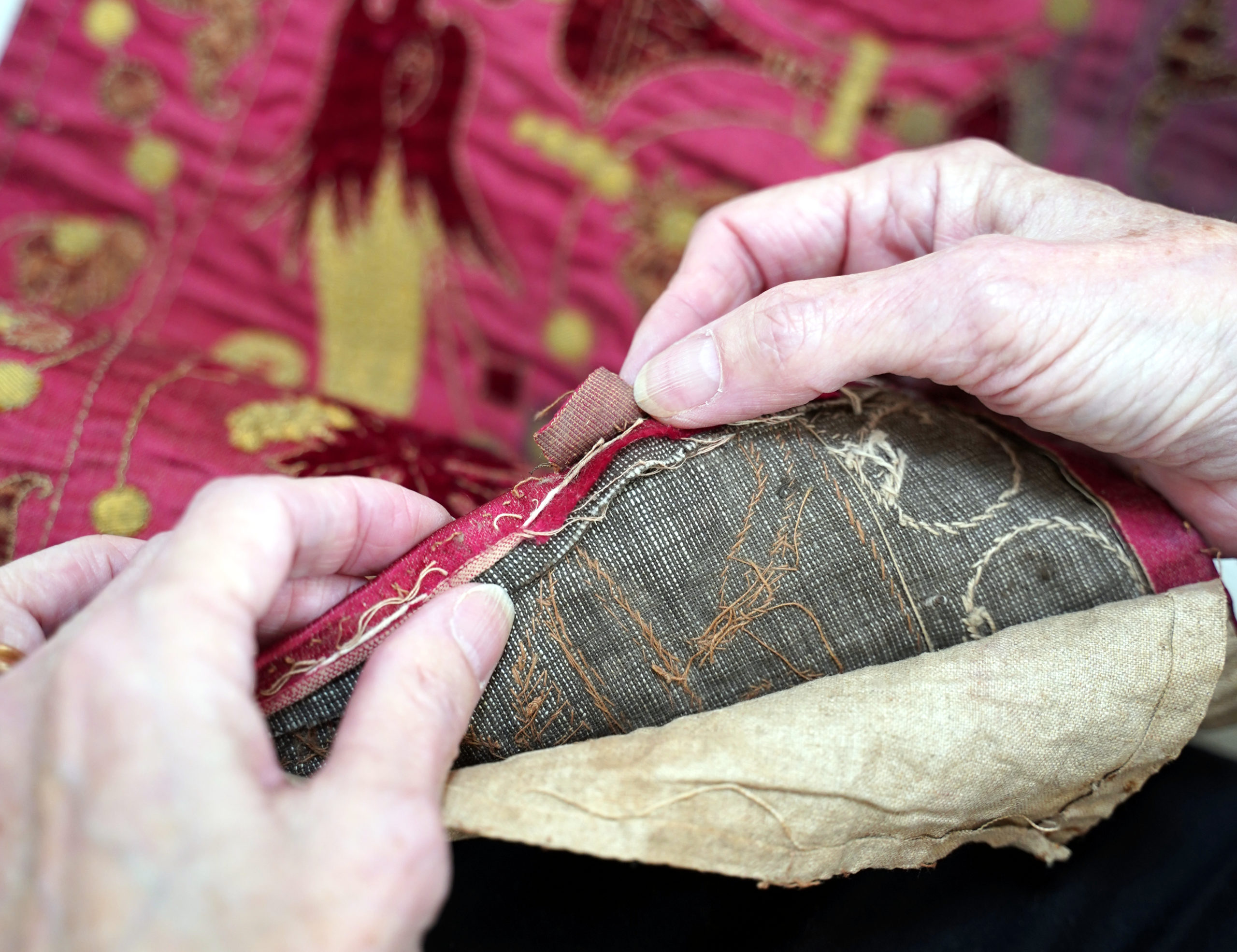
Embroidered Renaissance textile, collection of Meg Andrews, www.meg-andrews.com
Online via Zoom
The MEDATS Spring Conference will be held online via Zoom on Sunday 23 April 2023 between 13:00 and 17:30 GMT+1 (London Time). Attendance is open to all members of MEDATS without charge, and a registration link will be sent to members via email. Sessions will not be recorded.
Session 1, 1:00-2:15
Opening Remarks
President Gale Owen-Crocker
Bents as a Material of Early Modern Fashion: Their Origins, Uses and Demise in Sixteenth and Seventeenth-Century England
Sarah A. Bendall, Australia Catholic University
Bents were reeds and grasses used to structure the hoops of foundation garments such as
farthingales and bodies (stays), the undersleeves and shoulders of garments, and the bodices
of gowns. There has been little attempt to identify them as plants and there are few material
remains. Sarah A. Bendall uses wardrobe accounts and naturalist books, as well as
experimental history, to identify what bents were in sixteenth and seventeenth-century
English context, their materiality, usage and why they came to be replaced by later materials
such as whalebone.
A Tudor Bonnet Takes Shape
Challe Hudson, Independent Scholar
Portraits of early sixteenth-century queens show gable-shaped bonnets of very different
silhouettes. The jewels and soft materials of these bonnets may be effectively the same, so
Challe Hudson suggest that the key to their different shapes lies in the paste, the unadorned
white understructure visible against the cheek. From her investigation of hundreds of effigies
on tombs and brasses in parish churches of England and Wales Challe invites us to join her in
taking the measure of, and peering under the edges of, the uniquely English gabled bonnet.
Session 2, 2:30-4:00
The Mystery of the Norwich Child Jersey Stockings Knitters
Lesley O’Connell Edwards, Independent Scholar
In 1600 Thomas Wilson recorded that children in Norwich between six and ten years old
earned substantial sums by knitting jersey stockings, which were sold in London and abroad.
Lesley O’Connell Edwards considers what lies beneath Thomas Wilson’s comments, and
whether the evidence available refutes or substantiates his claims. She discusses the identity
of Wilson and his possible sources; jersey stockings, and evidence for trading them from
Norwich and their destinations; and Wilson’s monetary calculations.
Conjecturing the Clothes: Sixteenth Century Drawers Fit for an Italian Noblewoman
Chiaretta di Fiore, Independent Scholar
The wearing of drawers in sixteenth-century Italy is a debatable topic. It is unclear who wore
them, when, and why, though there is a commonly-held association with prostitutes. Some
textual evidence exists that noblewomen also wore them. However the only visual evidence
shows Venetian courtesans wearing ornate breeches, significantly different from three
surviving pairs of embroidered linen drawers. Chiaretta di Fiore describes research into
reconstructing a pair of drawers fit for an Italian noblewoman based on research into
materials, decorations, colours, stitches, and other design elements common to mid-sixteenth-
century Florence.
What Lies Beneath: Sixteenth-Century Pattern Books and the Underwear They Inspired
Hastings Sanderson, Independent Scholar
Decorative flourishes at collar and cuffs brought by lace and embroideries contribute to the
impression conveyed in European portraits of the sixteenth-century upper classes. Many can
be matched up with the pattern books published from the second decade of the 16th century.
Hastings Sanderson demonstrates that comparisons allow discussion of the design aesthetic
of the time, bringing together influences from the past as well as echoing new directions in
architecture, armour, and goldwork design; and that lace and embroidery patterns also
interact with technological advances in the publishing industry, scientific travelogues, and
botanical illustration.
Session 3, 4:15-5:30
A Recently Discovered Elizabethan Farthingale Sleeve
Ninya Mikhaila, The Tudor Tailor
In 2018 Ninya Mikhaila had the opportunity to examine a hitherto unknown and unique
survival of late Elizabethan fashion. Hooped sleeve supports, or farthingale sleeves, had
previously only been known through descriptions in documentary sources, whilst the
actual construction and appearance could only be conjectured. In this talk Ninya examines the
evidence for the development and uptake of the fashion in the sixteenth century as well as
details of the extant sleeve along with the story of its survival and preservation.
The Benefits of Wear: Examining the Support Structures of Embroidery
Erin Harvey Moody, Richmond Museum of History and Culture
Christy Gordon Baty, University of Nebraska, Kearney
The opulence of Elizabethan and Jacobean embroidery is partly due to its unique
dimensionality. Supporting structures were never meant to be seen, but Erin Harvey Moody
and Christy Gordon Baty, exploiting breakdown of silk and other materials, and natural (or
unnatural) wear and degradation over time, together with modern techniques like x-ray,
examine typical underlying materials like twine and wool, as well as wood forms, nutmegs,
shell hulls, and even the more exotic and unique birds’ beaks. They examine two-and three-
dimensional embroideries in several collections, including pictures, caskets, bags, frames and
book bindings.
